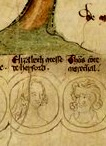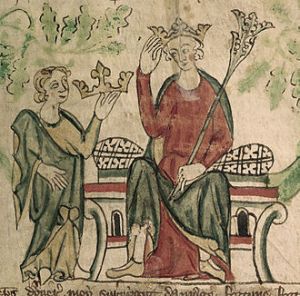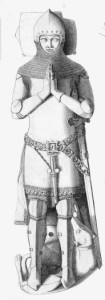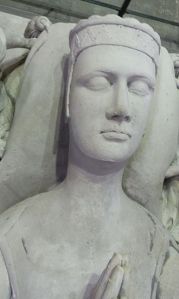In July 1282 King Edward I was in the middle of subduing Wales when his wife, Eleanor of Castile, was reaching her final month of pregnancy. Unlike most royal wives, who would have stayed at home in one of their sumptuous, cosy palaces, Eleanor was in Wales with her husband. After all, Eleanor had been on Crusade with her husband and had even given birth to her daughter, Joan of Acre, in the Holy Land. Wales was no more of a difficulty.
Rhuddlan Castle had been ‘civilised’ for the queen’s use; with the addition of gardens, decorative seating and a fish pond to aid Eleanor’s comfort. However, it was still Edward’s headquarters, where troops were mustering and messengers were coming and going at all hours – hardly the most comfortable and peaceful place for a queen to give birth.
Elizabeth of Rhuddlan was born around the 7th August 1282. She was the youngest surviving daughter of the king and queen’s 15 children – a 16th and final child, Edward (the future Edward II) would be born in 1284. Although the castle must have been hectic during Elizabeth’s birth, one can imagine the rooms surrounding the birthing chamber were kept as serene as possible. Indeed, it seems that Eleanor was allowed the ‘laying-in’ of a whole month following Elizabeth’s birth with her churching at the end of it – a luxury that did not arise all that often for Edward’s queen.
Eleanor’s wardrobe accounts show that the queen purchased several small items for her baby daughter’s use; a basin, some tankards, a storage chest and a bucket. And, unlike her siblings, Eleanor kept Elizabeth with her during the 1st few years of her life. It’s possible she was with her full-time until the age of 2, or was at least visited regularly by Eleanor. Elizabeth was still with her mother when her baby brother and the king’s heir, Edward, was born at Caernarfon in 1284.
When Edward was established in his own household, Elizabeth went with him. She spent most of her childhood in her brother’s company; her education supervised by her mother, often from a distance.
In 1285 Elizabeth and Edward spent the summer with their parents and older sisters. They visited Thomas a Becket’s shrine at Canterbury and spent a week at Leeds Castle in Kent before traveling to Amesbury in Wiltshire. Amesbury Priory was the retirement home of the dowager queen, Eleanor of Provence; and it was during the visit that Elizabeth’s 6-year-old sister, Mary, was veiled as a nun.
Edward I and Eleanor of Castile are famous for having had a close, loving relationship. They appear to have travelled everywhere together. Their children, however, were often left behind, usually in the care of their grandmother, Eleanor of Provence, Henry III’s queen and Edward I’s mother. In 1286, when Elizabeth was still only 3, they left England for the continent to broker peace between France and Aragon, in the hope of another Crusade. Although the Crusade never materialised, Edward and Eleanor were absorbed in their continental possessions until 1289.
However, the children were not forgotten. While in Paris Eleanor bought little items of jewellery for her daughters and sent them other pieces that had been given to her as gifts. She was also known to make offerings for her children’s health at any major shrines she visited.
Arriving at Dover after a 3 year absence, Edward and Eleanor were met by their children; 6-year-old Elizabeth and 4-year-old Edward probably had little or no memory of their parents. Following celebrations for their return in Canterbury, the royal family would spent the next 2 weeks at Leeds Castle, getting to know each other again.
Elizabeth and Eleanor were not especially close. Eleanor had spent half of her daughter’s life away on the Continent and Eleanor’s health began to fail shortly after her return. Elizabeth spent the summer of 1290 touring the countryside with her brother, only attending the court for the weddings of their sisters; Joan in April and Margaret in July.
In October 1290 Elizabeth was summoned to her ailing mother’s bedside at the royal hunting lodge of Clipstone in Nottinghamshire. Eleanor died at Harby in Lincolnshire on the 28th November 1290, the king accompanied her body back for burial at Westminster Abbey, ordering stone crosses to be erected at the places they stopped along the route.
We have no record of how Elizabeth reacted to her mother’s death, she was just 8 years old and had seen her mother rarely over the last 4 years. We can assume that she was saddened, but that life carried on pretty much as normal otherwise, with her day-to-day life remaining constant. In 1297 she and her sister Mary paid to have a special Mass held in honour of their mother, demonstrating their affection, and that she hadn’t been forgotten.
In 1297 Elizabeth’s marriage was celebrated; to John, Count of Holland. John had been educated at Edward’s court following his betrothal to Elizabeth in 1285. He had been one of the competitors for the Scots throne, though with only an outside chance. Elizabeth is said to have thrown a tantrum before the wedding, when not all her jewels were ready in time.
However, the royal wedding went ahead, at Ipswich Priory on 8th January 1297, when Elizabeth was just 14 years old and John was about 13. It seems Elizabeth was very fond of her father – there is some suggestion, too, that she was his favourite – and she was loath to leave him, and England. The king himself threw Elizabeth’s coronet into the fire during an argument over Elizabeth’s refusal to leave England with her husband. It took several letters from Count John, and cajoling from the king, to persuade Elizabeth to accompany her husband to her new country.
In the event, however, the arguing proved unnecessary as Count John died at Haarlem on 10th November 1299. Elizabeth, a childless widow at 17, returned home to her father’s court.
Almost exactly 3 years after the death of her 1st husband, on 14th November 1302, Elizabeth married again. This time there would be no arguments about leaving England as her husband was Humphrey de Bohun, 4th Earl of Hereford and Essex. Before the wedding Humphrey had relinquished all his lands and titles to the crown; after the wedding they were re-granted, jointly, to Humphrey and his new wife.
Elizabeth’s 2nd marriage appears to have been highly successful. Humphrey and Elizabeth weathered the storms of change together. Humphrey had been a stalwart of Edward I’s Scottish campaigns and in 1306 had been rewarded with the forfeited estates of Robert the Bruce. When Elizabeth’s father died in 1307, Humphrey was initially a supporter of the new king, Elizabeth’s brother and childhood companion, Edward II. He is witness to the document that created Piers Gaveston, Edward’s controversial favourite, Earl of Cornwall.
However, in 1310 he was named one of the lords ordainers, set up to reform the king’s household and government. He was stripped of his position as Constable of England for refusing to accompany the king on his Scottish campaign of 1310/11, but was reinstated the following year.
In 1314 Humphrey was one of the commanders of the English forces facing Robert the Bruce at Bannockburn. It is believed his arguments with Gilbert de Clare, Earl of Gloucester, over who should have precedence, was a major factor contributing to England’s defeat. Gloucester was killed in the fighting, but Humphrey was captured by the Scots; he was exchanged for Robert the Bruce’s queen, Elizabeth de Burgh, who had been held captive by the English since 1306.
Between 1303 and 1316, Elizabeth and Humphrey were to have 11 children, including twin boys, 8 of whom survived childhood; 6 boys and 2 girls. Their eldest daughter, Eleanor, married James Butler, 1st Earl of Ormonde and, following his death, Sir Thomas Dagworth, who was murdered in 1350. While their youngest surviving daughter, Margaret, married Hugh de Courtenay, Earl of Devon and lived until 1391.
Two of their sons would succeed, consecutively to the earldoms of Hereford and Essex; John and Humphrey. While William de Bohun, twin brother of Edward (who drowned in 1334), would be granted the title of Earl of Northampton by his cousin and close friend Edward III. The twin brothers had both been involved in Edward III’s escape from Nottingham Castle and the control of his mother’s lover, Roger Mortimer. Of the 2 remaining sons; Eneas died before 1343 and Edmund married Matilda, the daughter of Nicholas de Segrave, Baron Stowe.
Elizabeth died in childbirth on 5th May 1316; their last daughter, Isabella, died with her. They were buried together at Walden Priory in Essex on 23rd May.
Humphrey survived his wife by 6 years, being killed at the Battle of Boroughbridge in March 1322, fighting with the forces of Thomas of Lancaster against the king. Despite his will requesting he be buried beside his wife at Walden Priory, he was laid to rest at the Church of the Friars Preachers in York.
Elizabeth and Humphrey’s great-granddaughter, Mary de Bohun, married Henry Bolingbroke (the future Henry IV) and was the mother of 5 children, including Henry V.
*
Pictures courtesy of Wikipedia
*
Sources: The Oxford Companion to British History Edited by John Cannon; The Plantagenets, the Kings who Made England by Dan Jones; History Today Companion to British History Edited by Juliet Gardiner and Neil Wenborn; Brewer’s British Royalty by David Williamson; Britain’s Royal Families, the Complete Genealogy by Alison Weir; The Mammoth Book of British Kings and Queens by Mike Ashley; The Plantagenets, the Kings that made Britain by Derek Wilson; oxforddnb.com; Edward I; A Great and Terrible King by Marc Morris; Chronicles of the Age of Chivalry Edited by Elizabeth Hallam; Eleanor of Castile; the Shadow Queen by Sara Cockerill.
*
My Books
Signed, dedicated copies of all my books are available, please get in touch by completing the contact me form.
Defenders of the Norman Crown: The Rise and Fall of the Warenne Earls of Surrey tells the fascinating story of the Warenne dynasty, of the successes and failures of one of the most powerful families in England, from its origins in Normandy, through the Conquest, Magna Carta, the wars and marriages that led to its ultimate demise in the reign of Edward III. Defenders of the Norman Crown: Rise and Fall of the Warenne Earls of Surrey is now available from Pen & Sword Books, Amazon in the UK and US, Bookshop.org and Book Depository.
1 family. 8 earls. 300 years of English history!
Also by Sharon Bennett Connolly:
Ladies of Magna Carta: Women of Influence in Thirteenth Century England looks into the relationships of the various noble families of the 13th century, and how they were affected by the Barons’ Wars, Magna Carta and its aftermath; the bonds that were formed and those that were broken. It is now available in paperback and hardback from Pen & Sword, Amazon, Bookshop.org and from Book Depository worldwide.
Heroines of the Medieval World tells the stories of some of the most remarkable women from Medieval history, from Eleanor of Aquitaine to Julian of Norwich. Available now from Amberley Publishing and Amazon, Bookshop.org and Book Depository.
Silk and the Sword: The Women of the Norman Conquest traces the fortunes of the women who had a significant role to play in the momentous events of 1066. Available now from Amazon, Amberley Publishing, Bookshop.org and Book Depository.
Alternate Endings: An anthology of historical fiction short stories including Long Live the King… which is my take what might have happened had King John not died in October 1216. Available in paperback and kindle from Amazon.
*
You can be the first to read new articles by clicking the ‘Follow’ button, liking our Facebook page or joining me on Twitter and Instagram.
©2016 Sharon Bennett Connolly








Reblogged this on Lenora's Culture Center and Foray into History.
LikeLike
Thank you 🙂
LikeLike
Reblogged this on History's Untold Treasures and commented:
H/T History, the Interesting Bits
LikeLike
Thank you Meghan, much appreciated. 🙂
LikeLiked by 1 person
You’re welcome! Thanks for the great post!
LikeLike
Thank you so much. I enjoyed learning about Elizabeth and her family. Stacey
LikeLike
You’re welcome, Stacey. And thank you, I’m so glad you liked the post. Best wishes, Sharon 🙂
LikeLike
Reblogged this on evelynralph and commented:
More added to my history knowledge, all things come to pass.
Evelyn.
LikeLike
Thanks Evelyn. 🙂
LikeLike
Wonderful stuff. Thank you.
LikeLike
Thank you 🙂
LikeLiked by 1 person
For years, my mother’s side of the family has been linked back to Edward’s daughter, Joan of Acre. But after intensive research I’ve discovered the link doesn’t exist…instead, through a completely different branch of the family, we have a well-documented and uninterrupted line back to Elizabeth! I’m really enjoying learning about her. I consider myself an expert on Joan, but knew practically nothing about Elizabeth until today. Thanks for this interesting piece.
LikeLike
How fascinating! 🙂
LikeLike
Elizabeth “of Rhuddlan” Plantageneet is my 20th GGM. I love your stories of my ancestors.
LikeLike
Wonderful! 😀
LikeLike
I really enjoyed reading this. Thanks.
LikeLike
Thank you Liz, that is so lovely to hear. 🙂
LikeLike
Oh, I so enjoy reading all your postings, but have such a hard time keeping the Eleanors, Elizabeths, Williams and Henrys separated from the others of the same name. Wish they had thrown in a few different names, to keep us Yanks on track. Just kidding, of course. Being of English ancestry, I’m fascinated by the history of my ancestors. Thanks for all your hard work, Sharon,.
LikeLike
It confuses me too, Helen. I read about an Eleanor or Elizabeth and think ‘oh, I’ve written about her only to discover its a different Eleanor or Elizabeth.😀 Thanks for your kind comments, I really appreciate it. ☺
LikeLike
Sharon great post thanks for that.
You mention Edward III’s escape from Nottingham Castle – when was that? Do you have any details?
Best wishes
Terence
LikeLike
Hi Terence, Edward’s escape from Nottingham Castle was in 1330 and was part of his coup to displace Mortimer as effective ruler of England and take the reins of government himself. He and a few close, loyal friends took over the castle and arrested Mortimer in front of Queen Isabella, Edward’s mother. Best wishes, Sharon
LikeLike
Thank you so much!
LikeLiked by 1 person
Thank you 😁
LikeLike
Sharon, I enjoyed reading this post about Elizabeth of Rhuddlan. I’m a professional genealogist in the U.S. and, as you may know, many Americans are descended from “Gateway” colonists of royal descent who have Elizabeth in their family trees. I am one of those Americans myself with two immigrant ancestors to Virginia, Diana (Skipwith) Dale, and Col. Thomas Ligon, who were descended from Elizabeth of Rhuddlan by her great granddaughter, Lady Elizabeth Fitzalan by both of her marriages to Thomas de Mowbray, Duke of Norfolk, and Sir Robert Goushill of Hoveringham, Notts. I particularly enjoyed some of the information about Elizabeth of Rhuddlan’s personal behavioral characteristics. Those were details that I was not aware of myself after so many years of genealogical research. Thanks again!
LikeLike
You ‘re welcome Steve and thank you! I’m so glad you enjoyed the post. Best wishes, Sharon 😃
LikeLike
Thank you for your information about Elizabeth of Rhuddlan. I have been interested in her for many years. It is of course correct that she was buried in Walden Abbey but that is not Waltham Abbey. After a lot of research I have pinpointed her grave to underneath Audley End House which was built on top of the ruined abbey.
LikeLiked by 1 person
Thanks judith
LikeLike